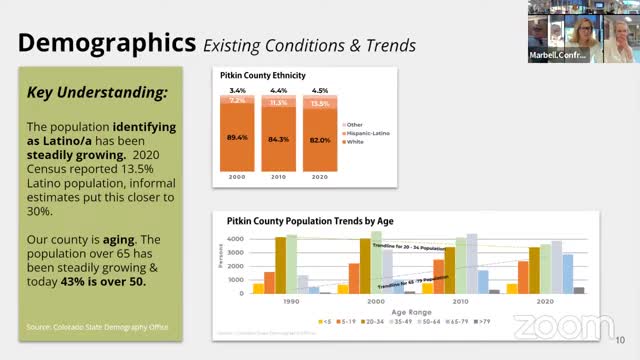Housing Crisis Deepens as Living Wage Falls Behind Costs
October 01, 2024 | Pitkin County, Colorado
This article was created by AI summarizing key points discussed. AI makes mistakes, so for full details and context, please refer to the video of the full meeting. Please report any errors so we can fix them. Report an error »

In a recent government meeting, officials discussed significant economic challenges facing Pitkin County, highlighting a stark disparity between living wages and median incomes. Since 2000, the living wage has surged by 200%, while median annual income has only increased by 62%, creating a gap of approximately $50,000. This discrepancy underscores the growing economic divide in the region, exacerbated by a housing market that has seen a dramatic increase in prices.
The meeting revealed that while the number of housing units has risen by 34,100 since 2000, a staggering 46% of these homes remain unoccupied, primarily serving as second residences. In contrast, the vacancy rate in Colorado stands at just 10.4%. The average cost of living in Pitkin County is now 220% of the national average, driven largely by skyrocketing housing prices, which have jumped from an average of $3 million in 2018 to nearly $7.9 million in 2024—a staggering 183% increase.
Employment trends were also a focal point, with 43% of the workforce engaged in the traditional tourist economy, which includes lodging and food services. However, many of these jobs are low to mid-wage, prompting concerns about the sustainability of this economic model. Notably, 62% of the workforce in Pitkin County commutes from outside the area, with 24% traveling over 50 miles for work. This reliance on external labor raises questions about the local economy's resilience, especially as neighboring counties offer competitive wages and job opportunities.
The meeting concluded with a call for strategic planning to address these economic disparities and housing challenges, emphasizing the need for a comprehensive approach to ensure a sustainable future for Pitkin County's residents.
The meeting revealed that while the number of housing units has risen by 34,100 since 2000, a staggering 46% of these homes remain unoccupied, primarily serving as second residences. In contrast, the vacancy rate in Colorado stands at just 10.4%. The average cost of living in Pitkin County is now 220% of the national average, driven largely by skyrocketing housing prices, which have jumped from an average of $3 million in 2018 to nearly $7.9 million in 2024—a staggering 183% increase.
Employment trends were also a focal point, with 43% of the workforce engaged in the traditional tourist economy, which includes lodging and food services. However, many of these jobs are low to mid-wage, prompting concerns about the sustainability of this economic model. Notably, 62% of the workforce in Pitkin County commutes from outside the area, with 24% traveling over 50 miles for work. This reliance on external labor raises questions about the local economy's resilience, especially as neighboring counties offer competitive wages and job opportunities.
The meeting concluded with a call for strategic planning to address these economic disparities and housing challenges, emphasizing the need for a comprehensive approach to ensure a sustainable future for Pitkin County's residents.
View full meeting
This article is based on a recent meeting—watch the full video and explore the complete transcript for deeper insights into the discussion.
View full meeting
